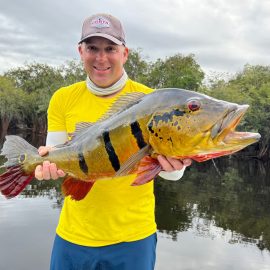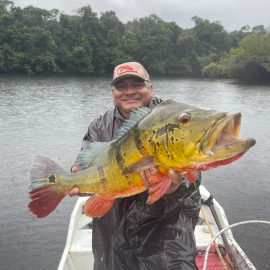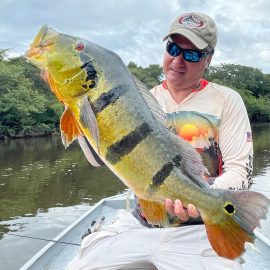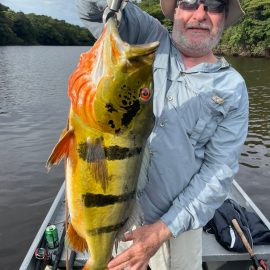Month: February 2022
Fishing Report: January 29th to February 19th, 2022
BEST-OF-BEST
2,050 Peacocks By 8 Anglers
Our 43 anglers during February had excellent fishing. Eight anglers broke waters on the upper Itapara with 2,050 peacocks of which 11 were 17-18lbs, two 19 lbs, one 20lbs, and one 21 lbs.
Stats: From January 29th thru February 19th 43 anglers landed in 6 ½ days 7,743 peacocks with 437 peacocks between 10 and 16 lbs.; 32 between 17 and 19 lbs.; and 6 between 20 and 22 lbs. (see the chart below) This tally excludes 4 large arapaimas, 7 large catfish, and a multifarious array of other tropical species such as the jacundá, apapá, cachorra, oscar, aruana, wolfish, pacú, bicúda, and pirañha.
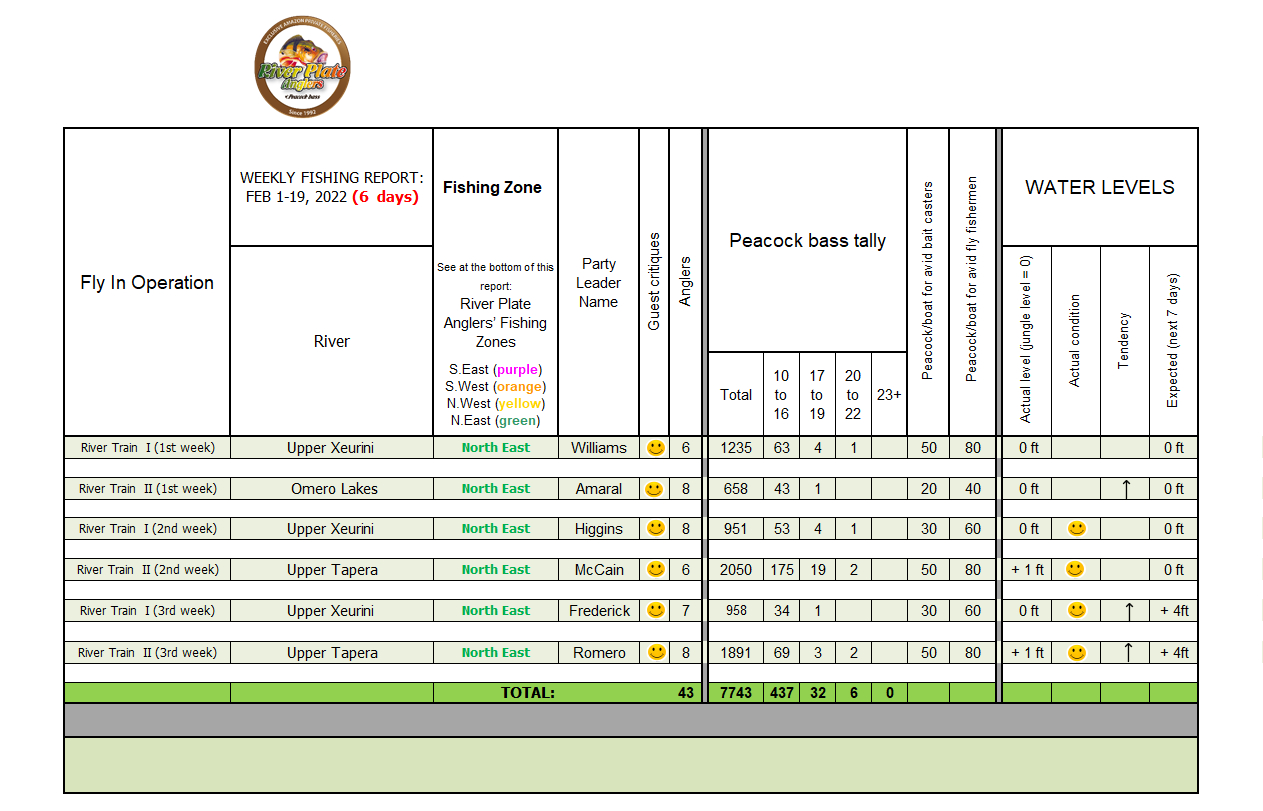 (click on the table to see it at full size)
(click on the table to see it at full size)
Guesswork:
Below we wish to inform our incoming anglers about the six River Train destinations, according to the expected water levels across our 10 Private Rivers.
South West Zone & South East Zone (scroll down to see map): All water levels continue to be high from Manaus down to 500 miles south as may be seen in the below design, which is normal at this time of the year.
 As such, we transferred two months ago all River Trains 300-400 miles North of Manaus to the North East Dry Zone were water levels and fishing have been very good. We fished a bit over the sustainable capacity on the Omero and Mata-Mata lakes waiting for low levels on the other private rivers in this Dry Zone. Finally, in the beginning of February we broke waters in our upper exclusive segments on the Itapara Jufaris and Xeurini . Water levels on these areas are excellent, see design below.
As such, we transferred two months ago all River Trains 300-400 miles North of Manaus to the North East Dry Zone were water levels and fishing have been very good. We fished a bit over the sustainable capacity on the Omero and Mata-Mata lakes waiting for low levels on the other private rivers in this Dry Zone. Finally, in the beginning of February we broke waters in our upper exclusive segments on the Itapara Jufaris and Xeurini . Water levels on these areas are excellent, see design below.
 However, these low water levels will only last until the end of February which, anyway, is the end of the season. This sudden future rise of water levels is evidenced by Todays and Last Week’s 10-Day Accumulated Rainfall Forecast being very high. Scroll down to see these forecasts.
However, these low water levels will only last until the end of February which, anyway, is the end of the season. This sudden future rise of water levels is evidenced by Todays and Last Week’s 10-Day Accumulated Rainfall Forecast being very high. Scroll down to see these forecasts.

 As such, we transferred two months ago all River Trains 300-400 miles North of Manaus to the North East Dry Zone were water levels and fishing have been very good. We fished a bit over the sustainable capacity on the Omero and Mata-Mata lakes waiting for low levels on the other private rivers in this Dry Zone. Finally, in the beginning of February we broke waters in our upper exclusive segments on the Itapara Jufaris and Xeurini . Water levels on these areas are excellent, see design below.
As such, we transferred two months ago all River Trains 300-400 miles North of Manaus to the North East Dry Zone were water levels and fishing have been very good. We fished a bit over the sustainable capacity on the Omero and Mata-Mata lakes waiting for low levels on the other private rivers in this Dry Zone. Finally, in the beginning of February we broke waters in our upper exclusive segments on the Itapara Jufaris and Xeurini . Water levels on these areas are excellent, see design below.
 However, these low water levels will only last until the end of February which, anyway, is the end of the season. This sudden future rise of water levels is evidenced by Todays and Last Week’s 10-Day Accumulated Rainfall Forecast being very high. Scroll down to see these forecasts.
However, these low water levels will only last until the end of February which, anyway, is the end of the season. This sudden future rise of water levels is evidenced by Todays and Last Week’s 10-Day Accumulated Rainfall Forecast being very high. Scroll down to see these forecasts.

10-Day Accumulated Rainfall Forecasts are for the towns below marked in pink which impact water levels in the North East Zone.
The accumulated rainfall over 2 inches means water levels may rise; between 1.5 and 2 inches means that water levels may drop slowly. On the other hand, rainfall between 1.5 and 1.0 inches means that levels will drop rapidly. Since the actual average of Today’s and Last Week’s 10-Day Accumulated Rainfall are more than two inches, water levels will rise.
Today’s 10-Day Accumulated Rainfall Forecast is as follows:
- Caracarai: 3.82 inches (marked as “1” in the 3 Month Rain Forecast Map below)
- Boa Vista: 1.78 inches (idem “2”)
- Rorainopolis: 4.69 inches (idem “3”)
- Barcelos: 4.11 inches (idem “4”) maybe considered slightly outside our fishery sphere-of-influence.
- Manaus: 4.36 inches (idem “5”) is outside our fishery sphere-of-influence. Used only as a reference.
- Caracarai: 1.87 inches (marked as “1” in the 3 Month Rain Forecast Map below)
- Boa Vista: 0.83 inches (idem “2”)
- Rorainopolis: 2.15 inches (idem “3”).
- Barcelos: 2.85 inches (idem “4”) maybe considered slightly outside our fishery sphere-of-influence.
- Manaus: 3.57 inches (idem “5”) is outside our fishery sphere-of-influence. Used only as a reference.
3-Month Rain Anomaly Forecast In Our Four Fishing Dry Zones
(Valid for February-March-April)

Source: CPTEC/INPE, Brazil
In the map above, the white color means normal rainfall forecasted. Note that our selected fishing area during January and February, which is the North East Zone, is in light blue, meaning that there is a slight positive anomaly; i.e.: this zone should receive slightly more rainfall than expected for this time of the year. Moreover, by Today’s and Last Week’s 10-Day Accumulated Rainfall Forecast shows that areas (towns) 1, 2 and 3 show high expected rainfall which is normal during season-end.This Week's Gallery
Fishing Report: January 8th thru 29th, 2022
PARADISE ISLAND
4,607 Peacocks Landed!
All of our 46 anglers during January 2022 had excellent fishing at our private Omero & Mata-Mata lakes despite high waters almost everywhere. Over 300 peacocks were over 10 lbs.

Stats: From January 1st thru the 29th 46 anglers caught in 6 ½ days 4,607 peacocks with 333 peacocks between 10 and 16 lbs.; 31 between 17 and 19 lbs.; and 3 between 20 and 22 lbs. (see the chart below) This tally excludes 12 large arapaimas, 23 large catfish, and a multifarious array of other tropical species such as the jacundá, apapá, cachorra, oscar, aruana, wolfish, pacú, bicúda, and pirañha.


(Click on the table to see it at full size)
Ammo: Since these fisheries are now reaching their sustainable season’s capacity, the most effective lures for bait casters were buck tail jigs, and to a lesser degree, all types of the light colored 6-inch topwater lures. For fly fishermen poppers for smaller fish worked, but the larger fish were caught on long white and red bucktail streamers on sinking lines.Guesswork:
Below we wish to inform our incoming anglers about the six River Train destinations, according to the expected water levels across our 10 Private Rivers.
South West Zone & South East Zone (scroll down to see map): Water levels are all high from Manaus down to 500 miles south as may be seen in the below design, which is normal at this time of the year.
 As such, we have transferred all River Trains 300-400 miles North of Manaus to the North East Dry Zone were water levels and fishing have been very good on the Omero and Mata Mata lakes. See design below.
As such, we have transferred all River Trains 300-400 miles North of Manaus to the North East Dry Zone were water levels and fishing have been very good on the Omero and Mata Mata lakes. See design below.
 And, imminently will also be very good on the upper Xeurini, upper Itapara and upper Shufaris as evidenced by Todays and Last week’s 10-Day Accumulated Rainfall Forecast. Scroll down to see these forecasts.
And, imminently will also be very good on the upper Xeurini, upper Itapara and upper Shufaris as evidenced by Todays and Last week’s 10-Day Accumulated Rainfall Forecast. Scroll down to see these forecasts.

 As such, we have transferred all River Trains 300-400 miles North of Manaus to the North East Dry Zone were water levels and fishing have been very good on the Omero and Mata Mata lakes. See design below.
As such, we have transferred all River Trains 300-400 miles North of Manaus to the North East Dry Zone were water levels and fishing have been very good on the Omero and Mata Mata lakes. See design below.
 And, imminently will also be very good on the upper Xeurini, upper Itapara and upper Shufaris as evidenced by Todays and Last week’s 10-Day Accumulated Rainfall Forecast. Scroll down to see these forecasts.
And, imminently will also be very good on the upper Xeurini, upper Itapara and upper Shufaris as evidenced by Todays and Last week’s 10-Day Accumulated Rainfall Forecast. Scroll down to see these forecasts.

10-Day Accumulated Rainfall Forecasts are for the towns marked in the green and yellow areas seen in the map below. The towns marked in pink and yellow below impact water levels in the North East Zone. The accumulated rainfall over 2 inches means water levels may rise; between 1.5 and 2 inches means that water levels may drop slowly. On the other hand, rainfall between 1.5 and 1.0 inches means that levels will drop rapidly. Since the actual average of Today’s and Last Week’s 10-Day Accumulated Rainfall is less than two inches, water levels will continue to drop.
Today’s 10-Day Accumulated Rainfall Forecast is as follows:
- Caracarai: 1.87 inches (marked as “1” in the 3 Month Rain Forecast Map below)
- Boa Vista: 0.83 inches (idem “2”)
- Rorainopolis: 2.15 inches (idem “3”)
- Barcelos: 2.85 inches (idem “4”) maybe considered slightly outside our fishery sphere-of-influence.
- Manaus: 3.57 inches (idem “5”) is outside our fishery sphere-of-influence. Used only as a reference.
- Caracarai: 0.57 inches (marked as “1” in the 3 Month Rain Forecast Map below)
- Boa Vista: 0.09 inches (idem “2”)
- Rorainopolis: 2.24 inches (idem “3”).
- Barcelos: 2.49 inches (idem “4”) maybe considered slightly outside our fishery sphere-of-influence.
- Manaus: 4.98 inches (idem “5”) is outside our fishery sphere-of-influence. Used only as a reference.
3-Month Rain Anomaly Forecast In Our Four Fishing Dry Zones
(Valid for February-March-April)

Source: CPTEC/INPE, Brazil
In the map above, the white color means normal rainfall forecasted. Note that our selected fishing area during January and February, which is the North East Zone, is in light blue, meaning that there is a slight positive anomaly; i.e.: this zone should receive slightly more rainfall than expected for this time of the year. However, by Today’s and Last Week’s 10-Day Accumulated Rainfall Forecast shows that areas (towns) 1, 2 and 3 still have low expected rainfall.



